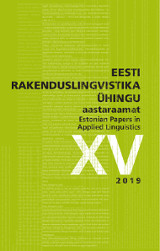Sõnaliigipiiridest kollokatsioonide vaatenurgast: erikäändelised noomenadverbid
Word class boundaries and collocations: the Estonian nominal adverbs in special cases
Author(s): Geda PaulsenSubject(s): Language studies, Morphology, Lexis, Semantics, Pragmatics
Published by: Eesti Rakenduslingvistika Ühing (ERÜ)
Keywords: word classes; collocations; lexicography; Estonian;
Summary/Abstract: This article discusses the fuzzy area between Estonian nouns and adverbs, here termed nominal adverbs (NAs). The focus is on abessive, comitative, translative and essive forms of nouns obtaining adverbial functions. The analysis of the collocative behaviour of the NAs is based on the data of the corpus query system Sketch Engine and the word sketches (Kilgarriff et al. 2004). The main question is whether there are NAs in these cases forming series, similarly to the adverbs in local cases. The analysis revealed two relational types or series of NAs. The first group constitutes antonymous abessive-comitative pairs (e.g. häireteta [disorder-pl-tra] ‘without a hitch’ : häiretega [disorder-pl-kom] ‘with hitch, badly’). These forms participate in a constructional pattern with the following characteristic features: the NA denotes an aberrancy (in comitative) or lack of an aberrancy (abessive); the NA has a plural form; the verb encodes a dynamic process. The meaning of these NAs has yet not distinctively diverged from their base nominals, except for the supplement of indefiniteness related to the plural form. The adverbial interpretation is in some cases supported by exceptionally high frequency of abessive and comitative forms in respect to the grammatical cases. The second group contains synonymous NAs in translative and essive, indicating comparative, adversative or summarizing pragmatic relationships (e.g. võrdluseks [comparison-tra] : võrdlusena [comparison-ess] ‘as a comparison’). The motivation behind the translative-essive alteration seems to be the case semantics – as the case of change of state, translative works best in resultative patterns and the atelic events make use of the essive case.
Journal: Eesti Rakenduslingvistika Ühingu aastaraamat
- Issue Year: 2019
- Issue No: 15
- Page Range: 121-137
- Page Count: 17
- Language: Estonian

